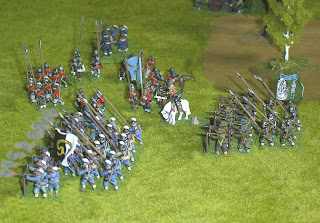
I bought these rules last year looking for something to replace my old WWII wargames rules; they came in a pretty boxed set, with reasonable production values and promised to allow simple, fast dynamic games. So we tried a scenario from the rules and found them to be rather, well murderous. Initially my players dismissed them, and so did I, but after a year or so I dug them out again to try with my 28mm's, and lo with a bit of reason, they work!
Actually this overlooked set of rules work pretty well.
I say overlooked, because they don't come from the usual stable of wargames rules producers; they may well be quite popular, but as they are made available in Britain via a model company, and originally herald from Italy (it certainly shows in some of the rule translation), they've passed the hardcore gamers by.
I do suspect an awful lot of people who never wargamed before are using these rules though, because of the way they've been marketed. And that is no bad thing. The rules themselves are a slim affair, suffering as stated from some vague translation, and, until you make the sensible revision of classing all terrain except roads as light cover, murderous.
What makes them work is the card system. Each player commands his forces through the turn by use of a hand of cards. Playing a card to a unit and declaring its' actions. The thing is any card played has an initiative value on it from 1 to 6; if the opponent wants to interrupt the player, he simply provides an order of a lower initiative value to one of his available units. The first player may respond in kind too, so you get a tit for tat style of action that allows for real uncertainty and some subtlety, without the need for written orders or arbitrary dice rolling. Genius!
So the game, the second with my 28mm's and these rules, saw Chris leading an American motor rifle platoon with an attached Tank Destroyer to clear a small village, somewhere in Northern France. Brian played the defending Germans; a reduced platoon of grenadiers, with an anti-tank gun and an armoured car in reserve.
 The end of the American advance; the crew of the lone half track have just seen their occupants raked my machine gun fire
The end of the American advance; the crew of the lone half track have just seen their occupants raked my machine gun fire
In paper strength the Germans were outnumbered two to one, but in reality they were able to stall the Americans easily with only a portion of their strength. The Americans lacked the will to come forward in strength, instead focusing on crawling through cover. Incredibly though they managed to miss the hidden enemy in buildings, who destroyed their command squad with well aimed machine gun fire.
 Americans advance through the woods
Americans advance through the woods
The Americans tried to rely on their mortar to bail them out, but it could see very little and the radio crews were having no luck directing it. What they wouldn't do was risk their tank, though the Pak 40 proved completely incapable of hitting anything
 A German squad, high above the lie of the land observe the Americans advancing into the open: 'Auf meinen zeichen, lassen sie Holle los!'
A German squad, high above the lie of the land observe the Americans advancing into the open: 'Auf meinen zeichen, lassen sie Holle los!' In the end the physical losses were similar, about 10 casualties each, but there was no hope of the Americans having the will to attack further and the game went to Brian's sensible control of the ground.
It was another big toys game for the club, and pleasing for me as it was the first full outing for my American Motor Rifles. Four Solido/Verem M3 half tracks clock in at a cool £80! All I need now for my 28mm WWII is a sprinkling more of American infantry, and I can call this lot done and dusted.











 They were beaten off, but this drew the white pikes away from my spearmen. With the crossbowmen, my spears were able to then surround and destroy the red pikes. At this point Chris conceded defeat, in what was a very close game.
They were beaten off, but this drew the white pikes away from my spearmen. With the crossbowmen, my spears were able to then surround and destroy the red pikes. At this point Chris conceded defeat, in what was a very close game.







